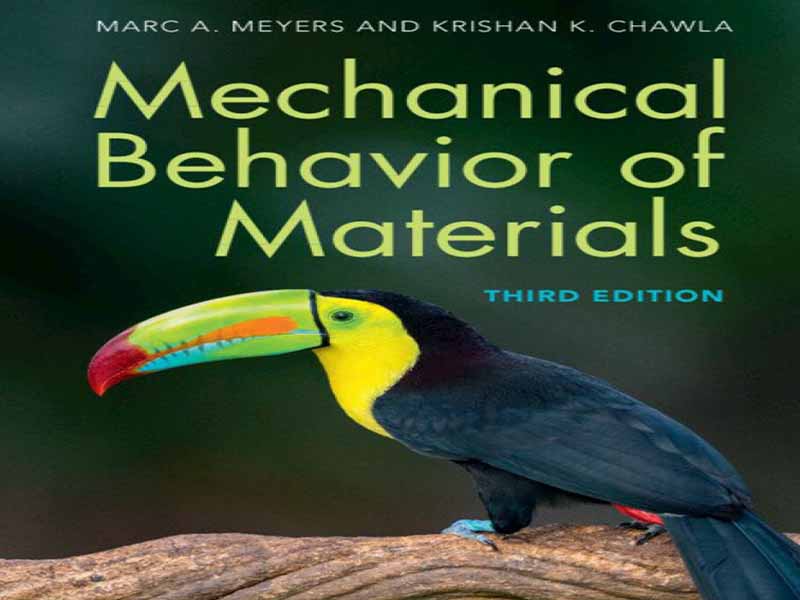- عنوان کتاب: Mechanical Behavior of Materials
- نویسنده: Marc A. Meyers, Krishan K. Chawla
- حوزه: توسعه آزمون محور
- سال انتشار: 2025
- تعداد صفحه: 343
- زبان اصلی: انگلیسی
- نوع فایل: pdf
- حجم فایل: 12.4 مگابایت
ما بسیار خوشحالیم که ویرایش سوم کتاب «رفتار مکانیکی مواد» را ارائه میدهیم. ویرایش اول توسط انتشارات پرنتیس-هال در سال ۱۹۹۸ منتشر شد. ویرایش دوم، تحت چاپ انتشارات دانشگاه کمبریج، در سال ۲۰۰۹ منتشر شد. ویرایش سوم اکنون در سال ۲۰۲۵ منتشر میشود. نیازی به گفتن نیست که ما همان مضمون اساسی کتاب، یعنی مکانیسمهای اساسی مسئول خواص مکانیکی مواد مختلف تحت شرایط محیطی متنوع، را حفظ کردهایم. ویژگی منحصر به فرد این کتاب، ارائه اصول مهم مسئول رفتار مکانیکی مواد، فلزات، پلیمرها، سرامیکها، کامپوزیتها، مواد بیولوژیکی و مواد الکترونیکی به شیوهای یکپارچه است. مضمون اصلی این است که ساختار (در سطح میکرو یا نانومتر) ماده، خواص ماده را کنترل میکند. اگرچه مضمون اصلی کتاب بدون تغییر باقی مانده است، ویرایش سوم با موارد زیر بهروز شده است: – پوشش پیشرفته از پیشرفتهای عمده در مواد، مانند فولادها، سرامیکها، پلیمرها، کامپوزیتها، مواد بیولوژیکی. به طور خاص، ما در مورد موارد زیر بحث میکنیم: ویژگیهای منحصر به فرد مواد بیولوژیکی از جمله هفتوجهی Arzt و عناصر طراحی ساختاری که امکان بررسی کمی مهندسی را فراهم میکنند در فصل 1؛ معادله اویلر، روشهای میانگینگیری الاستیسیته ایزوتنش و ایزوکرین (Voigt و Reuss) و اثرات ناهمسانگرد در فرمولبندی ماتریسی سختی در فصل 2؛ آلیاژهای با آنتروپی بالا در فصل 10؛ آزمایش مکانیکی میکروپیلار، EBSD (پراش الکترون به عقب پراکنده)، یک روش توصیف قدرتمند و بهروزرسانی شبکه محل انطباق در فصل 5؛ چقرمگی شکست مواد بیولوژیکی در فصل 7. – اشکال جدید فراوان برای بهبود ارائه و روشن شدن مفاهیم ارائه شده. – مثالها و تمرینهای جدید که به دانشجویان کمک میکند تا درک خود را بیازمایند. این کتاب عمدتاً برای استفاده در مقاطع بالاتر و دورههای تحصیلات تکمیلی مهندسی مکانیک و بخشهای علوم و مهندسی مواد در نظر گرفته شده است. با این حال، منبع مرجع خوبی برای مهندسان، دانشمندان و محققان شاغل نیز خواهد بود. ما سطح ریاضیات را کاملاً ساده نگه داشتهایم و به خواننده پیشنهاد میکنیم در صورت نیاز به فصل ۱ مراجعه کند، زیرا اطلاعات اولیه لازم در سطح مواد برای مطالعه این موضوع را ارائه میدهد. MAM مایل است از شرون تاوارس و آئومین هوانگ به خاطر کار شایسته و متعهدانهشان در ویرایش و مجوزها تشکر کند. اگر آنها نبودند، این ویرایش سوم هرگز به این روز نمیرسید. او همچنین از بویا لی برای مشارکت در تمرینها تشکر میکند. او از فرزندانش مارک مایرز و کریستینا ویندزور، نوههایش کلر، ایزابل و ابیگیل، و برادرانش پدرو، ژاک و کارلوس برای حمایت از او در این فرآیند سپاسگزار است. تشکر ویژه از لیندا همایون. KKC از K. Carlisle، N. Chawla، A. Goel، M. Koopman، R. Kulkarni، A Mortensen، B. R. Patterson، P.D. Portella و U. Vaidya برای بحثها و مشاورههای بیشمارشان سپاسگزار است. او به ویژه از کانیکا چاولا و ام. آرمسترانگ به خاطر کمکشان در زمینه آمار و ارقام سپاسگزار است. او مثل همیشه از اعضای خانوادهاش، آنیتا، کانیکا، نیکیل، نیمیش و نیوی به خاطر شکیباییشان سپاسگزار است.
We are very pleased to offer this third edition of Mechanical Behavior of Materials. The first edition was published by Prentice-Hall in 1998. The second edition, a Cambridge University Press imprint, came out in 2009. The third edition is now seeing the light of the day in 2025. Needless to say, we have maintained the same fundamental theme of the book, viz., the fundamental mechanisms responsible for the mechanical properties of different materials under a variety of environmental conditions. The unique feature of the book is the presentation in a unified manner of important principles responsible for mechanical behavior of materials, metals, polymers, ceramics, composites, biological materials, electronic materials. The underlying theme is that structure (at the micro or nanometer level) of the material controls the properties of the material. Although the basic theme of the book remains unchanged, the third edition has been updated with: – State-of-the-art coverage of the major developments in materials, such as steels, ceramics, polymers, composites, biologic materials. Specifically, we discuss: unique characteristics of biological materials including the Arzt heptahedron and structural design elements which enable a quantitative engineering treatment in Chapter 1; the Euler equation, elasticity averaging methods of isostress and isostrain (Voigt and Reuss), and anisotropic effects to matrix formulation of stiffness in Chapter 2; High-Entropy Alloys in Chapter 10; Micropillar mechanical testing, EBSD (electron back-scattered diffraction), a powerful characterization method, and coincidence site lattice update in Chapter 5; fracture toughness of biological materials in Chapter 7. – Many new figures to improve the presentation and to clarify the concepts presented. – Fresh worked examples and exercises that help the students test their understanding. The book is principally meant for use in the upper division and graduate level courses of mechanical engineering, and materials science and engineering departments. However, it will also be a great source of reference material to the practicing engineer, scientist, and researcher. We have kept the level of mathematics quite simple, and suggest the reader to refer back to Chapter 1 if needed, as it provides the basic materials-level information necessary to study this subject. MAM would like to thank Sheron Tavares and Aomin Huang for their competent and dedicated work in the revision and permissions. This third edition would never have seen the day if it were not for them. He also thanks Boya Li for contributing with exercises. He is grateful to his children Marc Meyers and Cristina Windsor, his granddaughters Claire, Isabelle, and Abigail, his brothers Pedro, Jacques, and Carlos for supporting him through this process. A special thanks is due to Linda Homayoun. KKC is grateful to K. Carlisle, N. Chawla, A. Goel, M. Koopman, R. Kulkarni, A Mortensen, B. R. Patterson, P.D. Portella, and U. Vaidya, for their innumerable discussions and counsels. He is especially grateful to Kanika Chawla and M. Armstrong for their help with figures. As always, he is thankful to his family members, Anita, Kanika, Nikhil, Nimeesh, and Nivi for their forbearance.
این کتاب را میتوانید از لینک زیر بصورت رایگان دانلود کنید:
Download: Mechanical Behavior of Materials




































نظرات کاربران